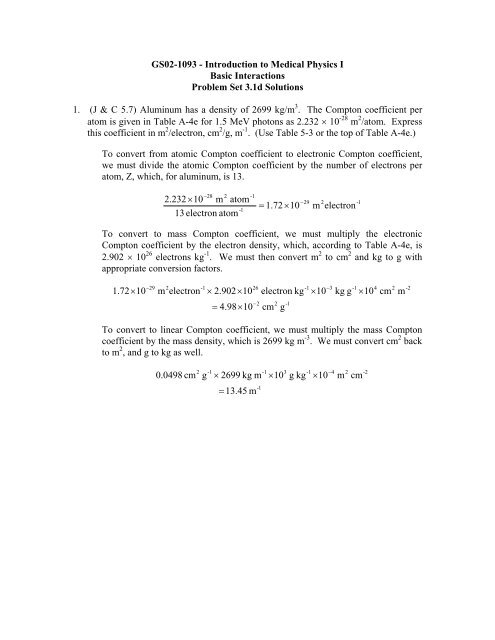link to Problem Set 3.1d Solutions - UT-H GSBS Medical Physics ...
link to Problem Set 3.1d Solutions - UT-H GSBS Medical Physics ...
link to Problem Set 3.1d Solutions - UT-H GSBS Medical Physics ...
You also want an ePaper? Increase the reach of your titles
YUMPU automatically turns print PDFs into web optimized ePapers that Google loves.
GS02-1093 - Introduction <strong>to</strong> <strong>Medical</strong> <strong>Physics</strong> I<br />
Basic Interactions<br />
<strong>Problem</strong> <strong>Set</strong> <strong>3.1d</strong> <strong>Solutions</strong><br />
1. (J & C 5.7) Aluminum has a density of 2699 kg/m 3 . The Comp<strong>to</strong>n coefficient per<br />
a<strong>to</strong>m is given in Table A-4e for 1.5 MeV pho<strong>to</strong>ns as 2.232 10 -28 m 2 /a<strong>to</strong>m. Express<br />
this coefficient in m 2 /electron, cm 2 /g, m -1 . (Use Table 5-3 or the <strong>to</strong>p of Table A-4e.)<br />
To convert from a<strong>to</strong>mic Comp<strong>to</strong>n coefficient <strong>to</strong> electronic Comp<strong>to</strong>n coefficient,<br />
we must divide the a<strong>to</strong>mic Comp<strong>to</strong>n coefficient by the number of electrons per<br />
a<strong>to</strong>m, Z, which, for aluminum, is 13.<br />
<br />
13 electron a<strong>to</strong>m<br />
28<br />
2 -1<br />
2. 232 10 m a<strong>to</strong>m<br />
29<br />
1.<br />
7210<br />
-1<br />
m<br />
2<br />
electron<br />
To convert <strong>to</strong> mass Comp<strong>to</strong>n coefficient, we must multiply the electronic<br />
Comp<strong>to</strong>n coefficient by the electron density, which, according <strong>to</strong> Table A-4e, is<br />
2.902 10 26 electrons kg -1 . We must then convert m 2 <strong>to</strong> cm 2 and kg <strong>to</strong> g with<br />
appropriate conversion fac<strong>to</strong>rs.<br />
1.<br />
7210<br />
29<br />
m<br />
2<br />
electron<br />
-1<br />
2.<br />
90210<br />
26<br />
4.<br />
9810<br />
2<br />
electron kg<br />
cm<br />
2<br />
g<br />
-1<br />
-1<br />
10<br />
3<br />
kg g<br />
-1<br />
-1<br />
10<br />
To convert <strong>to</strong> linear Comp<strong>to</strong>n coefficient, we must multiply the mass Comp<strong>to</strong>n<br />
coefficient by the mass density, which is 2699 kg m -3 . We must convert cm 2 back<br />
<strong>to</strong> m 2 , and g <strong>to</strong> kg as well.<br />
0.<br />
0498 cm<br />
2<br />
g<br />
-1<br />
2699 kg m<br />
-1<br />
13.<br />
45 m<br />
-1<br />
10<br />
3<br />
g kg<br />
-1<br />
10<br />
4<br />
m<br />
2<br />
cm<br />
-2<br />
4<br />
cm<br />
2<br />
m<br />
-2
2. (J & C 5.10) A beam of pho<strong>to</strong>ns with energy 100 keV suffers Comp<strong>to</strong>n collisions.<br />
Find the minimum energy of the scattered radiation, the maximum energy the recoil<br />
electron may acquire, and the mean energy of the recoil electron.<br />
The maximum energy transfer <strong>to</strong> the electron will occur when the electron is<br />
scattered in a forward direction and the pho<strong>to</strong>n is scattered backward. The<br />
minimum pho<strong>to</strong>n energy is given by<br />
1<br />
h<br />
min h<br />
1<br />
2<br />
1<br />
100 keV<br />
100<br />
1<br />
2<br />
511<br />
100<br />
keV<br />
1.<br />
391<br />
71.9 keV<br />
The maximum energy of the recoil electron is given by<br />
2<br />
h<br />
max h<br />
1<br />
2<br />
100<br />
2<br />
100 keV 511<br />
100<br />
1<br />
2<br />
511<br />
100<br />
0.<br />
391<br />
keV<br />
1.<br />
391<br />
28.1<br />
keV<br />
(We note that if we add the two energies, we get 100 keV, which is the energy of<br />
the incident pho<strong>to</strong>n beam.)<br />
To obtain the mean energy of the recoil electron, we use J & C equation 6-15.<br />
<br />
tr Etr h<br />
<br />
For 100 keV pho<strong>to</strong>ns in a free-electron gas, we have<br />
tr<br />
E<br />
<br />
0.<br />
0680<br />
100 keV<br />
0.<br />
4927<br />
13.<br />
8 keV
3. (J & C 5.12) A slab of carbon of thickness 3 10 23 electrons per cm 2 is bombarded<br />
by 10 6 pho<strong>to</strong>ns of energy 1.0 MeV. Calculate the number of Comp<strong>to</strong>n interactions,<br />
the energy diverted from the beam, the energy transferred <strong>to</strong> kinetic energy of<br />
charged particles, and the energy scattered. Make an energy balance.<br />
The number of pho<strong>to</strong>ns undergoing no Comp<strong>to</strong>n interactions is given by N=N0e -x ,<br />
so the number of pho<strong>to</strong>ns undergoing a Comp<strong>to</strong>n interaction is given by NC =<br />
N0(1-e -x ). From Table A-2a, the Comp<strong>to</strong>n coefficient for 1 MeV pho<strong>to</strong>ns is<br />
0.2112 10 -28 m 2 electron -1 , so<br />
x<br />
0.<br />
2112 10<br />
N<br />
C<br />
<br />
0.<br />
0634<br />
10<br />
10<br />
6<br />
6<br />
28<br />
0.<br />
0634 1e 0. 0614<br />
4<br />
6.<br />
14 10<br />
<br />
<br />
2<br />
m<br />
310<br />
electron<br />
23<br />
electron<br />
10<br />
2<br />
cm<br />
4<br />
cm<br />
2<br />
m<br />
Note that the target is thick, so it is not completely correct <strong>to</strong> use a linear<br />
approximation.<br />
The energy diverted from the beam is the 1.0 MeV beam energy multiplied by the<br />
number of Comp<strong>to</strong>n interactions, or 6.14 10 4 MeV.<br />
The energy transferred <strong>to</strong> charged particles is the average energy transferred by a<br />
Comp<strong>to</strong>n interaction multiplied by the number of Comp<strong>to</strong>n interactions. The<br />
average energy transferred by a Comp<strong>to</strong>n interaction for 1.0 MeV pho<strong>to</strong>ns is<br />
given in Table A-2a as 0.440 MeV, so the energy transferred <strong>to</strong> charged particles<br />
is 2.70 10 4 MeV.<br />
The energy scattered is equal <strong>to</strong> the energy diverted that is not transferred <strong>to</strong><br />
charged particles, or (6.14 – 2.70) 10 4 MeV = 3.44 10 4 MeV.<br />
2
4. (J & C 6.10) A detec<strong>to</strong>r of area 2.5 cm 2 is placed 30 cm from a block of scattering<br />
material containing 10 23 electrons/cm 2 . A beam of 10 6 pho<strong>to</strong>ns with 1 MeV energy<br />
bombards the block. The detec<strong>to</strong>r is placed along a line making an angle of 45 with<br />
the direction of the pho<strong>to</strong>n beam. Find the number of scattered pho<strong>to</strong>ns that reach the<br />
detec<strong>to</strong>r (use Fig. 6-4)<br />
The number of scattered pho<strong>to</strong>ns reaching the detec<strong>to</strong>r, N, is the product of the<br />
number of incident pho<strong>to</strong>ns, , the number of electrons in the target, Ne, the<br />
differential scatter cross-section, and the solid angle subtended by the detec<strong>to</strong>r.<br />
The differential scatter cross-section, as taken from Fig 6-4, is 2.7510 -30 m 2<br />
electron -1 steradian -1 , for 1 MeV pho<strong>to</strong>ns scattered an angle of 45. So,<br />
d<br />
N<br />
<br />
d<br />
2<br />
6 23 electron<br />
30<br />
m 2.<br />
5<br />
4 cm<br />
10 10<br />
2.<br />
7510<br />
steradian 10<br />
2<br />
2<br />
2<br />
cm<br />
electron<br />
steradian 30<br />
m<br />
7.<br />
64<br />
N e<br />
5. (J & C 6.11) A beam of 10 6 pho<strong>to</strong>ns with 0.8 MeV energy bombards a block of<br />
scattering material containing 10 23 electrons/cm 2 . Find the number of electrons<br />
produced with energies in the range of 0.2 <strong>to</strong> 0.25 MeV (use Fig. 6-5)<br />
The number of electrons produced in an energy interval, N, is the product of the<br />
number of incident pho<strong>to</strong>ns, , the number of electrons in the target, Ne, the<br />
differential (energy) scatter cross-section, and the energy interval. The<br />
differential (energy) scatter cross section for 0.8 MeV pho<strong>to</strong>ns in the range of<br />
energies 0.2 MeV <strong>to</strong> 0.25 MeV, as taken from Fig 6-5, is approximately 38 10 -30<br />
m 2 electron -1 MeV -1 . So,<br />
d<br />
N<br />
T<br />
dT<br />
6 23 electron<br />
10 10<br />
3810<br />
2<br />
cm<br />
3<br />
1.<br />
910<br />
N e<br />
30<br />
2<br />
2<br />
m<br />
4 cm<br />
0.<br />
05 MeV 10<br />
2<br />
electron<br />
MeV<br />
m<br />
2





